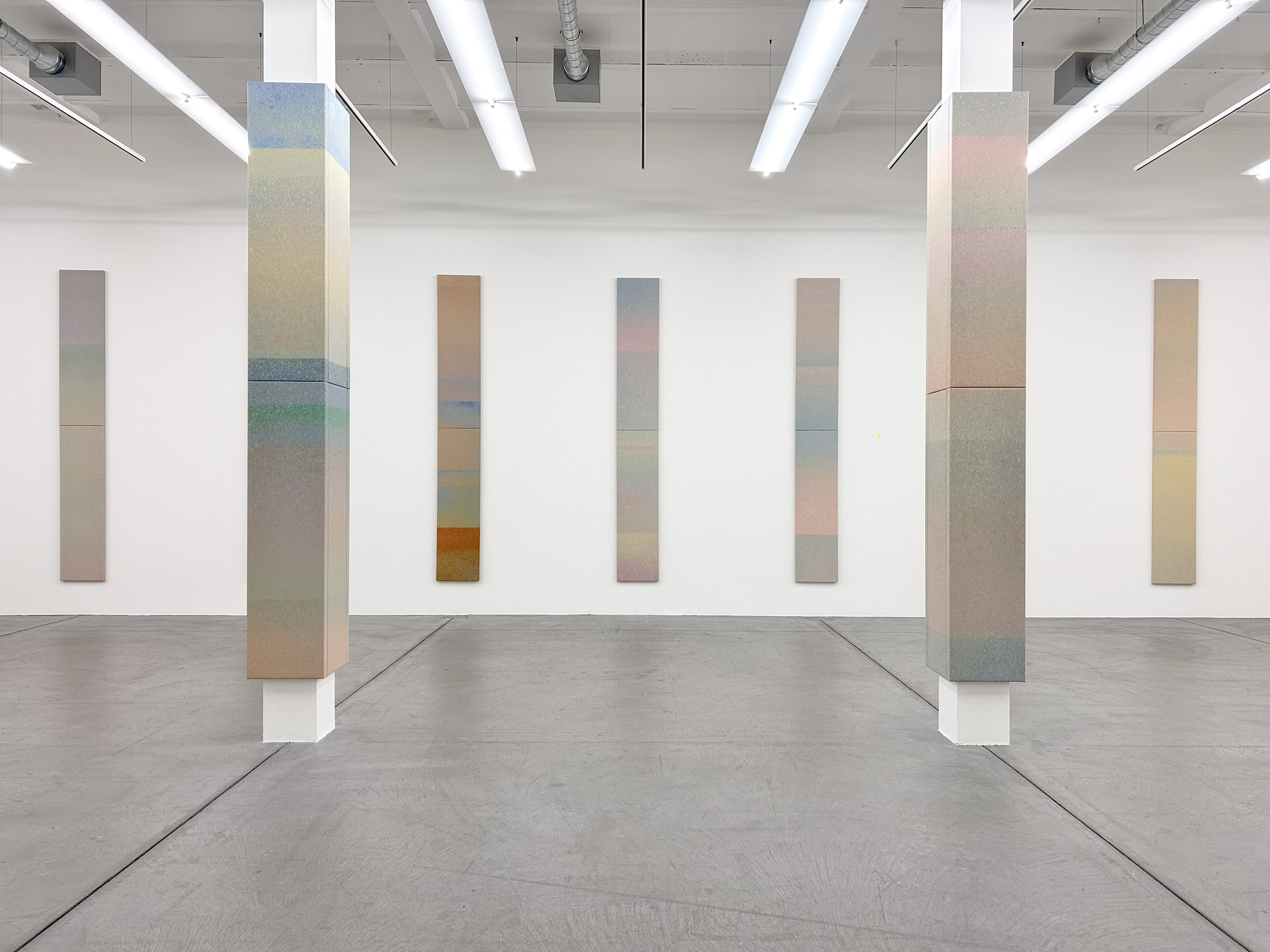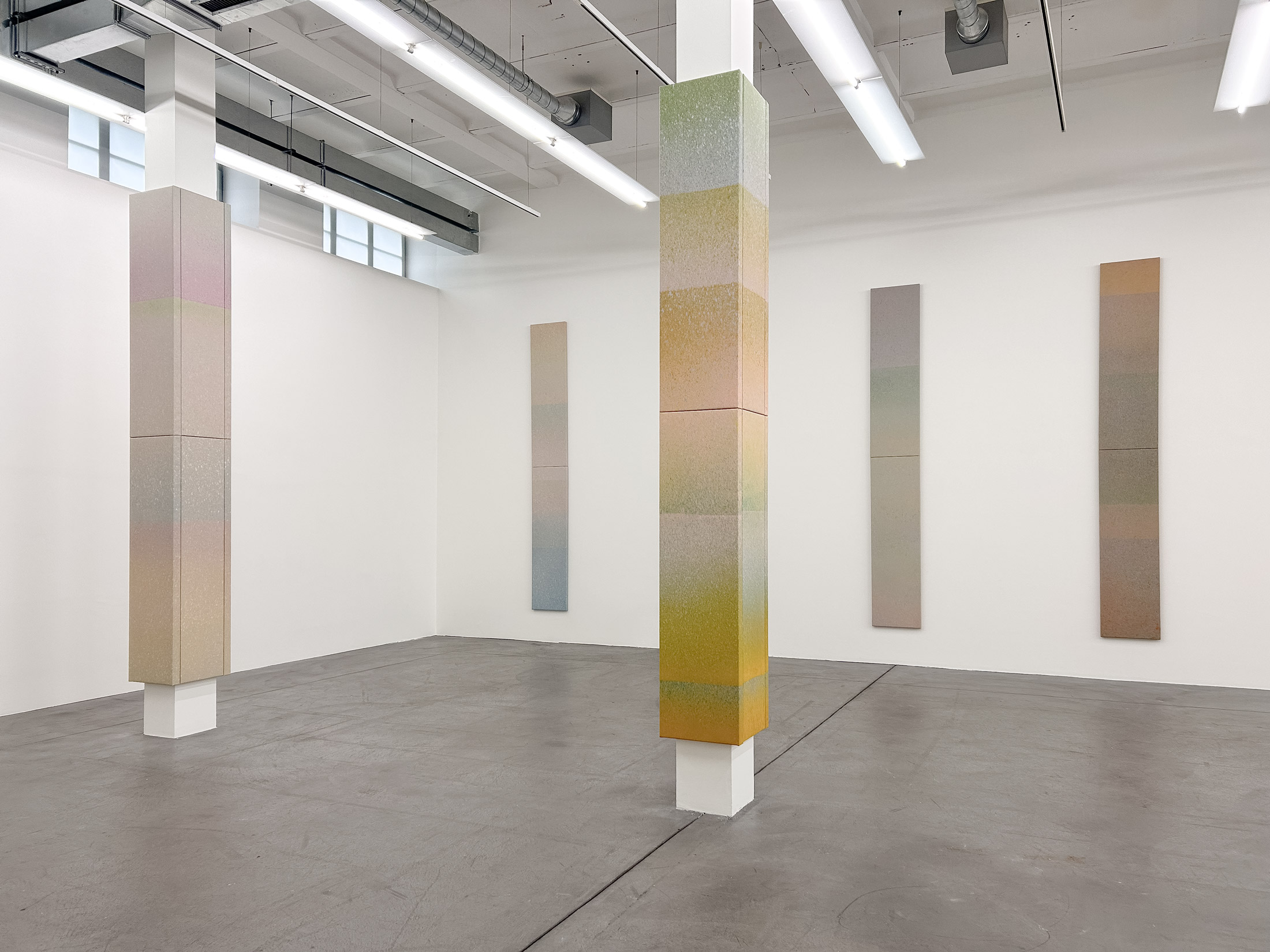Synaptic Splendour
Project for “Concepts of The All-Over” exhibition at Haus Konstruktiv Museum (Zurich, Switzerland)
3 Oct 2024 – 13 April 2025
![]()
3 Oct 2024 – 13 April 2025

The project Synaptic Splendour is a meditation on consciousness, the nature of the human experience and the inherent subjectivity within perception. By blending neuroscience, phenomenology, and diverse literary inspirations, Montiel’s work traces the invisible threads connecting our inner worlds to the external reality we shape and inhabit. Synaptic Splendour was produced for Haus Konstruktiv’s exhibition “Concepts of The All-Over”, and it unfolds across the large hall and adjoining rooms on the museum’s 4th floor, offering a sensory and philosophical journey into the mechanisms of experience.
At the heart of the exhibition is The Cortical Columns (deepening into our shared fictions), a site-specific installation that transforms the architecture of the space into a metaphor for neural processes. Referencing the vertical structures of the brain that translate sensory input into perception, Montiel’s work reimagines the museum’s columns as elements of this organic system. Encased in narrow painted panels that stretch to the walls, the columns form a network of interwoven spaces, symbolizing the permeability of perception.

The paintings in this installation are part of Montiel’s entoptic paintings series —entos (inside) and opsis (seeing)—. This technique was born with the intention of depicting the blurred and uncertain reality we experience on a daily basis. Through a meticulous layering process, Montiel applies acrylic paint using her signature spray-gun technique, then reworks the surfaces by hand. This method produces a mesmerizing duality: from a distance, the paintings appear as shimmering, ethereal fields; up close, they reveal intricate constellations of dots. The interplay of iridescence and precision creates a dynamic visual effect that shifts with light and perspective, inviting viewers to experience perception itself as fluid and mutable.
Montiel’s exploration of consciousness bridges Western and Eastern philosophies. She draws on Thomas Metzinger’s concept of the self as a brain-generated simulation while embracing Eastern ideas about the illusory nature of reality. Her work suggests that perception is not a passive act but an active process of construction, where reality is continuously remade through the mind’s interpretive lens.

This dialogue extends into two adjacent rooms, where Montiel presents immersive video installations that explore contrasting states of awareness. The first, Istigkeit (Naked Existence), takes its title from a term used by Meister Eckhart to describe pure being. Inspired by Aldous Huxley’s The Doors of Perception (1954), the piece conjures a world of vibrant, organic forms that emerge and dissolve in an endless cycle of transformation. Huxley’s description of perceiving flowers—alive with radiant “is-ness” under the influence of mescaline—resonates in Montiel’s ever-shifting visual landscapes, where transience and eternity intertwine.
The second video, Khoreia (dancing in unison), offers a quieter, more introspective counterpoint. Drawing on Gaston Bachelard’s The Poetics of Reverie (1961), Montiel explores how poetic imagination can illuminate the depths of the human soul. The work choreographs a delicate interplay of imagery and emotion, inviting viewers to step into a state of meditative reverie where the boundaries between reality and imagination dissolve.
Through her paintings and video installations, Montiel creates a multisensory survey on the architecture of perception. Her work reveals the fragile, ever-changing nature of the systems that shape our experience, suggesting the world not as a fixed reality but as a dynamic interplay of mind, matter, and meaning.

Credit for the above photograph: Conradin Frei






ISTIGKEIT: A MEDITATION ON THE
IS-NESS OF BEING
In Istigkeit, the viewer is drawn into a profound meditation on the fluidity and diversity of perception, inspired by Aldous Huxley’s The Doors of Perception. The title of the video, derived from Meister Eckhart’s term for “is-ness,” reflects the work’s exploration of existence as an ever-present, radiant phenomenon.
The video weaves computer generated imagery and narration to evoke the transformative power of direct experience. Huxley’s vivid description of perceiving flowers—shining with their inner light, charged with paradoxical significance—serves as the heart of the piece. His words, narrated Ana Montiel’s voice, guide viewers to contemplate the miracle of naked existence, the divine paradox of transient yet eternal life.
Istigkeit is an invitation to reconsider the boundaries of perception, offering a glimpse into consciousness unbound from the habitual filters of the mind. Each state of awareness available to us unveils new layers of meaning, suggesting a reality that itself is a dynamic interplay of becoming and being.
It is a call to embrace the Beatific Vision in the ordinary—a rose, a carnation, an iris—and to recognize in their ephemeral presence the eternal truth of Being. To witness the grace and transfiguration inherent in the simplest of forms.
KHOREIA
In Khoreia, the realm of imagination converges with reality, creating a contemplative artwork inspired by Gaston Bachelard’s The Poetics of Reverie. This video is a meditation on poetic phenomenology—a lens through which the psyche becomes the choreographer of its own reality, echoing Carl Jung’s notion that we shape the world through the dynamics of our inner lives.
The title, drawn from the ancient Greek word for "dancing in unison," reflects the intricate choreography of elements that shape our experience: symbols, poetry, images, reflections and reverie intertwined in a perpetual dance.
The poetic image, as Bachelard suggests, is the origin of consciousness—a profound meeting point of perception and subjectivity. It arises from the phenomena of the psyche, an ever-unfolding process that colors our understanding of the world with textures of emotion, memory, and dream. Through this lens, perception is no longer a passive reception but an active, poetic act.
Khoreia evokes a dance of interconnected forces, where imagination reconfigures the boundaries between self and world. By intertwining the ideas of Bachelard and Jung, this work explores how the poetic and phenomenal nature of the psyche shapes our lived reality. Through reverie, Khoreia invites viewers into a dynamic, collective dance of inner and outer world—a profound reminder that consciousness is a living, poetic phenomenon in motion.




